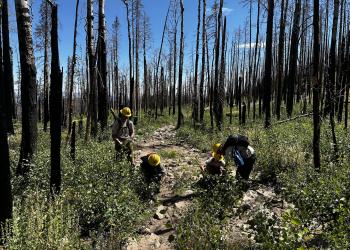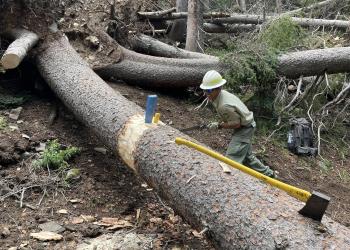Current Conditions
Winter 2025
Below freezing temperatures and snow, especially at ski resort level, can turn the forest into a winter wonderland, but your safety is paramount.
The potential for avalanches can exist within certain areas of the forest during winter conditions. Visitors are advised to check for information from the Taos Avalanche Center and consider the Forest Service's safety tips for avalanches.
Overnight temperatures begin to drop below freezing in the fall. Learn more about hypothermia and how to prevent it.
Winter driving can pose its own challenges. Here are some tips to keep in mind when traveling through the forest:
- The New Mexico Department of Transportation manages state highways through the forest. Check nmroads.com for real-time alerts and closures.
- Follow the National Highway Transportation Safety Administration detailed winter driving tips.
- Check current and forecast weather conditions.
- Most of the Forest Service roads are open at this time of year, seasonally closing Jan. 1, but conditions and vehicle type/driver ability may limit access. Due to ever-changing conditions on the ground, the Carson National Forest does not maintain a list road conditions.
- Pack extra layers of clothing, including rain gear, socks, gloves or mittens, and a warm hat.
- Bring a winter emergency kit, which should include a flashlight, map and compass, matches in a waterproof container, whistle, fire-starter, nylon cord, pocketknife, high-energy food, plastic tarp, space blanket, signal mirror, first aid kit, duct tape for repairs, and a metal container for melting snow.
Go to Know Before You Go: Driving for more tips.
Seasonal winter road closures for vehicles go into effect Jan. 1 annually. Most reopen around May 1. Visitors may still use the roads by other means, such as hiking, snowshoeing and cross-country skiing.
Wildfire activity subsides in the winter, but crews will continue to take advantage of the conditions for prescribed fire, usually pile burning when snow is on the ground. Smoke impacts are typically minimal and short in duration.
Planning a Hike?

To help you get the most of our your experience, dig deeper with these tips.
Post-Incident Conditions
Specific incidents may quickly change conditions for the long-term in a geographic area.
Hermits Peak-Calf Canyon Fire

Partner groups are helping address trail damage from the 2022 Hermits Peak-Calf Canyon Fire, which crossed into the Carson National Forest and burned approximately 16,000 acres.
2021 Windstorm

An intense windstorm called a squall significantly affected areas of the forest in 2021. Most trails have reopened, but crews and volunteers continue their work in 2025.
Seasonal Conditions
Preparing for a trip in the future? Here are the general conditions for the other seasons of the year:
Spring
Spring is a period of transition with the winter thaw and fire season overlapping. Here are the typical conditions to prepare for in spring each year:
The potential for a significant fire season is forecasted for this spring, when New Mexico is typically in its peak fire season. Fire restrictions could go into effect earlier than usual.
Visitors are encouraged to:
- Check fire restrictions before heading out.
- Prepare for dry and windy conditions.
- Have a backup plan in case a wildfire prompts closures or creates unhealthy air quality.
- Check the National Weather Service's fire weather page for active watches, warnings or advisories about fire conditions.
Visitors may encounter a number of impacts to Forest Service roads:
- Snow, especially at higher elevations.
- Downed trees and boulders.
- Flooding and mud (spring is called "mud season" by locals)
Before heading out, let someone know your plans. Go to our driving safety page for more safety tips.
Seasonal Closures
Many roads on the forest are seasonally closed through May 1.
State Roads
Check nmroads.com for highway statuses.
Peak run-off from melting snow typically occurrs mid- to late May, including Memorial Day Weekend. Visitors may encounter the following impacts or hazards:
- Flooded roads, trails or recreation sites.
- Fast-moving rivers.
- Cold water.
- Unstable banks.
Tips
- Check the Rivers and Streams section on Know Before You Go: Water Safety.
- For flooding advisories and warnings, use to the National Water Prediction Service.
Spring is the windiest season in New Mexico. While it fuels fire danger, it can also create other hazards:
- Falling trees and branches are always a hazard, especially when wind is present.
- Strong winds can make driving difficult, especially high profile vehicles such as motorhomes, campers and trucks. Be careful on bridges and overpasses.
Check the National Weather Service's hazards map for active watches, warnings or advisories about wind.
Snow and overnight freezing temperatures at higher elevations can easily remain into May and June, impacting roads and trails, especially shaded segments. If you head out, prepare for conditions that may limit access.
- Have equipment for travelling in the snow and know how to use it.
- Dress in layers and bring extra supplies.
- Conditions can change, moving from soft snow to ice as the day progresses.
Find more tips on our Winter Conditions Safety webpage.
Wildlife encounters become more prominent as temperatures warm up. Here are some species to take note of, with links to safety tips:
Summer
Summertime is monsoon season, which brings with it numerous weather hazards that can put visitors at risk for serious injury or death.
Lightning is so common, it is the number one cause of wildfires on the Carson National Forest. It is also most unexpected hazard for many vistiors, since it can strike well outside a storm itself, often the first to arrive and last to leave as a thunderstorm passes by. Increase your safety with these actions:
- Watch for signs of an approaching thunderstorm
- Postpone outdoor activities if thunderstorms are imminent. This is your best way to avoid being caught in a dangerous situation
- If you can hear thunder, you are close enough to a storm to be struck by lightning
- Get inside a house, large shelter or an all-metal vehicle (not a convertible). If safe shelter is not available, find a low spot away from trees, fences and poles
- If boating or swimming, get out of boats and away from the water, get to land and find shelter immediately
- Remain clear of tall, isolated trees and telephone poles.
Summer thunderstorms are often associated with intense rainfall over a brief time period, producing more water than the ground can absorb. Flash floods can occur with little or no warning, move at very fast speeds and can reach a peak in a few minutes with little to no warning.
- Know your area's flood risks and weather hazard bulletins by visiting weather.gov or local news stations.
- Stay alert for signs of heavy rain with thunder and lightning where you are and upstream. Watch for rising water levels.
- Get to higher ground before flooding happens.
- It is NEVER safe to drive or walk into floodwaters. Turn Around Don't Drown®
- Avoid areas already flooded, especially if the water is flowing fast.
- Do not attempt to cross flowing streams.
- Don't try to swim to safety; wait for rescuers to come to you.
- Be especially cautious at night when it is harder to recognize and respond to danger. During threatening conditions, do not camp or park your vehicle along streams and rivers.
- Be Ready
Altitude affects UV radiation, which increases about 2% for every 1,000-foot increase in elevation due to thinner mountain air. That means for a higher-elevation place like Carson National Forest, UV radiation is generally higher:
- About 14% higher in areas around the Town of Taos (~7,000 ft.)
- About 26% higher at Wheeler Peak (~13,000 ft.).
It only takes minutes to damage your skin. Even on cool and cloudy days, sun damage is possible if you don’t take precautions, such as:
- Finding shade.
- Coveromg up.
- Using sunscreen.
- Protecting your eyes.
For more details on these precautions go to the Forest Service's Know Before You Go: Sun Safety and the CDC.
Regardless of the dry atmosphere, the high temperatures of New Mexico can result in numerous health issues.
- Sun burns.
- Heat cramps.
- Heat exhaustion.
- Heat stroke.
Take the extra time to protect yourself and others from heat related illness.
- Drink plenty of water. Avoid sugary drinks and alcohol, as they can lead to dehydration.
- Stay in the shade whenever possible.
- Schedule the most rigorous activities for early or later in the day.
- Wear lightweight, loose-fitting, light-colored clothing.
- Keep a close eye on older adults, children and those with chronic medical conditions.
Learn to identify the signs of heat stress and get more tips.
Fire activity can range widely, depending on the timing and strength of monsoon season.
- Lightning is the number one cause of fires on the forest, and may spark new starts.
- Fire restrictions may start in or continue into summer from spring if it is weak or delayed.
- If conditions are right, fire managers may manage a naturally-caused start or conduct a prescribed fire for forest and watershed health.
On years with a heavier monsoon, roads can become very muddy and hard to pass. Just like in the spring, let someone know your plans before heading out. Go to our driving safety page for more safety tips.
The best way to avoid these hazards during the monsoon season is by staying alert of the weather conditions and avoiding the threat before it occurs. Many opportunities are available to gain weather information including:
- Monitoring current weather forecasts on TV or the internet.
- Listening to weather reports on the radio or a NOAA weather radio.
- Subscribing to lightning and severe weather notification services.
- Scanning the skies 360 degrees around and overhead before leaving a safe location.
Fall
Autumn can be a busy season on the forest, with deer and elk hunting dates in effect, leaf peepers checking out fall color and fire crews conducting prescribed fires.
Fall weather usually does not produce significant wildfire potential, but it can in some years (e.g. the Luna Fire in October 2020).
Typical autumn conditions are, however, the best time to conduct prescribed fire operations to improve forest and watershed health. Potential locations are usually available by the end of summer.
Hunting occurs year-round on the forest, with the height of it taking place in the fall, when deer and elk hunts take place. Hunters should be aware of rules and safety tips when on their hunts.
Overnight temperatures begin to drop below freezing in the fall. Learn more about hypothermia and how to prevent it.


